In 1993 the IMA acquired its first and only work by Jenny Holzer. The IMA’s 1983 piece is Untitled and consists of selections from her “Truisms Series.” It is the first in an edition of four. Cybernetic Data Products fabricated the original, which used an internal computer processor to send signals to the red LED lights to display Truisms in a variety of patterns–they flashed, dashed, blinked, etc.
Today, when you take the escalators to the contemporary galleries on the 3rd floor you will encounter this work installed just above the elevator. But this isn’t really the same sign that Ms. Holzer made in 1983… what’s there now is a little bit different.
By doing some quick research in the IMA’s conservation, curatorial, and registration department’s files I was able to piece together Untitled‘s exhibition and conservation history, and even discover its previous owners and pre-IMA exhibition locations. Why did I do this? I wanted to know about its conservation history and I was looking for some guidance on “correct” installation parameters. Truth be told, I was really looking for a note from Ms. Holzer or one of her assistants that stated precisely how the work should and shouldn’t be installed. Does it have to be above a door? Or entryway? Can it be hung like a painting, 62″ on center? How about pushed into a corner?
The variable installation locations of this artwork make it dynamic and somewhat playful in that it can represent an authoritative voice and at the same time question authoritative voices. While of course a certain amount of common sense could be and should used when installing it—after all, it is a sign and it gives information so it seems rather straightforward to install it in a place where we would find a “sign” and also authoritative information. The IMA has only installed the work in one other location. In the image below taken last week you can see a gallery placard (a sign!) just about exactly where Untitled was installed from 1993-2003.
In addition to looking at the IMA’s files I also searched IDAA (the INCCA Database for Artists’ Archives) which led me to this case study on Inside Installations website about Ms. Holzer’s 1997 installation at the Guggenheim Bilbao Museoa, Proyecto para Bilbao. While the Guggenheim’s installation is a lot more complex than the IMA’s, there are many similarities related to its preservation and future.
[wpaudio url=”https://magazine.art21.org/wp-content/uploads/2009/08/300e1.mp3″ text=”Audio guide for Proyecto para Bilbao at the Guggenheim Bilbao Museoa that includes an interview with the artist”]
In the case study for the Guggenheim installation an interview was conducted with the artist that outlines a process for intervening with the work in the event a component deteriorates. This document is titled “Questionary” and you can read it in its entirety here. While I don’t know the conservation history of the piece in Bilbao, this document is helpful because it provides a clear approach to future conservation work. For example, it states:
“Following artist instructions in case of deterioration of any of the components [in] the piece can be intervened [with] at several levels:
1. Replacement of any of the original components with equal new pieces.
2. Replacement of any of the original components with similar new pieces.
3. In the future if any of the two options above are unfeasible due to the obsolescence of equipments [sic] the installation could be adapted to new technologies.”
While the IMA does not have the advantage of a document like this pertaining directly to its work on file yet, over the years we have taken care of our piece by making sure that all interventions were done with the artist’s approval in the same way that this document suggests. For example, in 1996 the internal motherboard was replaced after a power surge damaged it. This work was completed by Cybernetic Data Products (the original manufacture), but by late 2000 the piece was not functioning properly. Unfortunately by this time Cybernetic also was no longer in business.
It was decided that the only way to repair the piece was to replace the original sign component with a similar one. This was done by Sunrise Systems, a company that has fabricated a number of pieces for Ms. Holzer, including those in her recent show “Protect Protect.” Though Sunrise Systems fabricated a new piece that contained the same programming as the original, the end result was a sign that is 6 1/2″ shorter in length, a 1/2″ shorter in height and 1/2″ longer in width. The new dimensions of the piece are now 6 (h) x 53 1/2 (L) x 4 1/2 (W) as compared to the original 6 1/2 (h) x 60 (L) x 4 in (W). Despite the dimensional differences, the piece still uses red LEDs and still displays the same “Truisms.” I doubt anyone other than a select few could even notice the difference. To demonstrate how carefully we’ve looked at it recently, I can say with a certain amount of clarity that the new sign has 896 red LEDs in a 7 x 128 grid. I’m happy also to report that the piece has worked fine since 2000, requiring very little maintenance
Current appearance of Jenny Holzer's work, Untitled, which was re-fabricated by Sunrise Systems in 2000 © 1983 Jenny Holzer
I had these things on my mind when I visited Washington, D.C. last month to attend a workshop on petrographic and ceramic analysis led by Chandra Reedy at the Freer Gallery of Art. In addition to attending the workshop, I also set aside some time to visit the Lunder Conservation Center at the Smithsonian American Art Museum (SAAM). If you haven’t been to Lunder, you ought to, really. And if you want to see a Flickr set I created about my visit there, with an oblique Hoosier reference to this movie, go here. But I digress.
For a while now I’ve been aware of the Smithsonian’s Holzer installation, and I was interested to find out more about it from my friend, Hugh Shockey, Object Conservator, Lunder Conservation Center, SAAM. During my visit we had a number of involved conversations about some of the more complex works on the 3rd floor of the SAAM. We talked about the two massive Paiks, the fascinating Hockney installation, and the Jean Shin exhibition, but we spent the majority of our time looking at and talking about the recently commissioned work by Ms. Holzer. Since the visit, we’ve been exchanging e-mails about this work and our approaches to the conservation and representation of the works under our care. Here’s part of our conversation:
Richard McCoy: From a technical perspective will you describe For SAAM?
Hugh Shockey: For SAAM is a site specific, time-based media sculpture that was commissioned for the Smithsonian American Art Museum in 2007. For a definition of what I mean by “time-based media,” check out the Tate’s website which also talks about some important contemporary conservation issues. The work is made up of 120 vertical strands of circuitry that contain 61,200 individual white LEDs. Sunrise Systems designed the electronics and did the programming while another firm, Tri Pyramid, was involved with the design and fabrication of the base plate. The electronic circuitry and programming allow it to display text in a variety of patterns. The text used in this column of light came from four of the artist’s series including Truisms, Living (selections), Survival (selections) and Arno. The full sequence of text and patterns reveals itself over the course of a little more than 24 hours. So, if you were to come the museum every day at the same time the text would be different.
The part of the work visible to the visitor hangs from the ceiling, roughly 28 feet above the floor. Yes, it is literally hanging there; while the base plate may appear to be touching the ground, it is not. The base plate is actually quite heavy and supplies tension to the circuitry strands so that they are pulled straight. In the ceiling, above the sculpture and what the public can’t see are the large power supplies/transformers (remember if it is “electronic” it needs DC electricity), fiber optic data signal converter, and computer that actually run the piece.
RM: How long did it take to assemble the piece in the gallery?
HS: I believe it took two weeks to install and for Ms. Holzer to “sign off” on the programming and sequencing the piece. I was not actually involved in the early stages of installation. My involvement began when the installation was already in progress. When I first saw the piece, the strands were partially assembled. Some of the components had to be delivered through the third floor window that overlooks F street. You can see a picture of it being installed on our blog right here.
RM: So does someone have to turn the piece on and off, or is it on a timer?
HS: The piece runs continuously. So it’s only when there’s an issue that my technician, Susan Edwards, or I have to turn the unit on or off. From a preservation stand point this is both good and bad. Having it on all the time has the advantage of not subjecting the electronics to the surge of electricity that occurs when the power button is pushed. It really doesn’t degrade the life of the LED’s terribly since each individual LED is only on for a fraction of a second. The down side of having it on all the time is that it has the potential to subject the work to larger power issues from the city’s power grid: blackouts, brownouts, basically things that happen with the power that we have no control over. These are the same concerns you have with your computer plugged into the wall at home. On the non-preservation side of things it takes a considerable effort to get to the on/off switch. It’s much like an obstacle course in the attic above the piece.
RM:Is there maintenance involved in keeping it working?
HS: Yes, I have done a little maintenance, mainly as the sculpture has “settled.” What I mean by this is the sort of slow process of change that occurred as the full effects of gravity and the weight of the base plate took hold and pulled the residual twist out of the stands. These were artifacts of the manufacturing and fabrication process. This process was accounted for in the design, so, it was not a surprise really. The work that I’ve done has been confined to repairing broken solder joins and replacing damaged LED’s. The most invasive procedure that I’ve done on the piece has been to replace segments of strand that have stopped working properly. Luckily taking an interest during the installation allowed me to work with the engineers from Sunrise Systems who gave me a little hands-on training with the soldering procedures.
RM: Really, so you’ve done soldering work on this piece?
HS: Yeah, and you know, for the most part all of the solder joints are tiny. The LEDs themselves are only 2mm x 1mm x 1mm and each of the bridges between the segments has 12 solder points in the space of 13mm x 8mm. Thankfully, Ms. Holzer thought ahead and left us with parts for repair and replacement if necessary; also we have spoken with her and interviewed her so that we record her views on the long-term care of the piece and how she viewed the technology in relation to her artistic intent. To summarize Ms. Holzer’s comments, I would say that she has no problem with the technology of the work being updated if necessary as long as the aesthetics remained very near the original, but, interestingly, she expressed the desire for the technology of the sculpture to not change or be updated in the event of her death.
RM: Can you talk about what your concerns are for this piece 30-40 years from now? Do you think your predecessors will have the skills, means, any technology to keep it working correctly?
HS: My long-term preservation concern for a work like For SAAM is really the ability to acquire replacement parts. That is to say that the components that make up the aesthetic portion of the work, particularly since this is very important to Ms. Holzer. The difficulty I envision is that because the strands are a custom made and patented design that we will not be able to get additional replacements in say 30 years or more, or even sooner. It really depends a lot on the longevity of Sunrise Systems and then how soon the fabrication method for the existing components becomes obsolete. This is already a huge issue for us when it comes to our collection of Nam June Paik’s. I mean really, when was the last time you saw a CRT monitor on a shelf for sale?
For further reading check out this 2007 interview with Jenny Holzer in Smithsonian magazine.

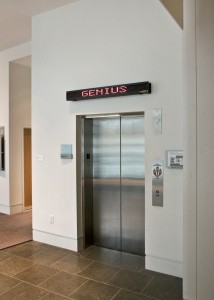
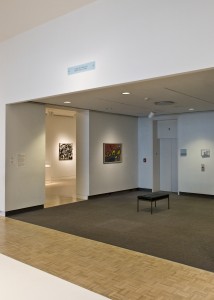
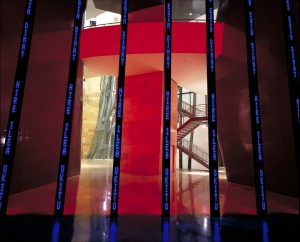
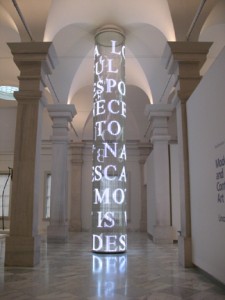
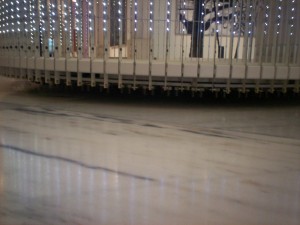
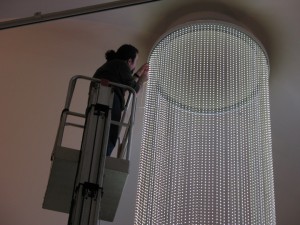
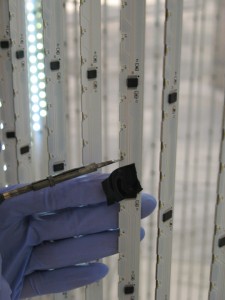
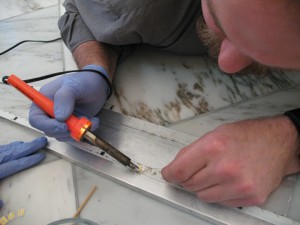



Pingback: Wednesday Clips for 8/19/09 : Bad at Sports
Pingback: Spiders, Basque, Kindness, and Cruelty | newelty | travel, novelty, and a pinch of snark
Pingback: No Preservatives | Preserving Digital Art: A Case Study | Art21 Blog